模拟式控制器
- 格式:pptx
- 大小:2.00 MB
- 文档页数:58
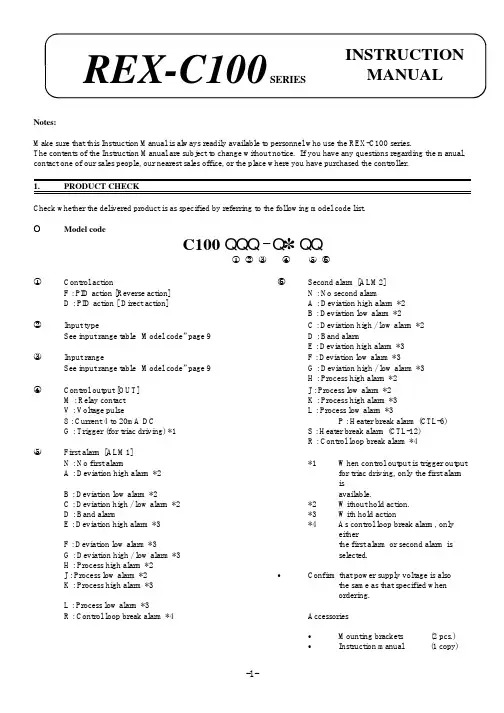
Notes:Make sure that this Instruction Manual is always readily available to personnel who use the REX-C100 series.The contents of the Instruction Manual are subject to change without notice. If you have any questions regarding the manual,contact one of our sales people, our nearest sales office, or the place where you have purchased the controller.1.PRODUCT CHECKCheck whether the delivered product is as specified by referring to the following model code list.OModel codeC100 QQQ - Q ~ QQÎ Ï Ð Ñ Ò ÓÎControl actionÓSecond alarm [ALM2]F : PID action [Reverse action]N : No second alarmD : PID action [ Direct action]A : Deviation high alarm *2B : Deviation low alarm *2ÏInput typeC : Deviation high / low alarm *2See input range table “Model code” page 9D : Band alarmE : Deviation high alarm *3ÐInput rangeF : Deviation low alarm *3See input range table “Model code” page 9G : Deviation high / low alarm *3H : Process high alarm *2ÑControl output [OUT]J : Process low alarm *2M : Relay contact K : Process high alarm *3V : Voltage pulseL : Process low alarm *38 : Current 4 to 20mA DCP : Heater break alarm (CTL-6)G : Trigger (for triac driving) *1S : Heater break alarm (CTL-12)R : Control loop break alarm *4ÒFirst alarm [ALM1]N : No first alarm*1When control output is trigger output A : Deviation high alarm *2for triac driving, only the first alarm isB : Deviation low alarm *2available.C : Deviation high / low alarm *2*2Without hold action.D : Band alarm*3With hold actionE : Deviation high alarm *3*4As control loop break alarm, only eitherF : Deviation low alarm *3the first alarm or second alarm is G : Deviation high / low alarm *3selected.H : Process high alarm *2J : Process low alarm *2CConfirm that power supply voltage is alsoK : Process high alarm *3the same as that specified when ordering.L : Process low alarm *3R : Control loop break alarm *4Accessories C Mounting brackets (2 pcs.)CInstruction manual(1 copy)REX-C100SERIESINSTRUCTION MANUALFig. 1Fig. 22.MOUNTING •DimensionsUnit : mm (inch)* Dimensions in inches are shown for reference•Mounting proceduresThickness of panel board:1 to 5mm or 5 to 9mm (0.04 to 0.20 inch or 0.20 to 0.35 inch)uWhen the controllers are mounted on panel with 1 to 5mm in thickness ÎMake a rectangular cutout corresponding to thenumber of controllers to be mounted on panel by referring to the panel cutout dimensions.ÏSince the mounting brackets are already installed onthe controller, insert the controller into the panel from the panel front without removal of the brackets (Fig. 1).uWhen the controllers are mounted on panel with 5 to 9m in thickness ÎRemove the mounting brackets from the controllerwith a slotted screwdriver.ÏEngage each mounting bracket with holes markedwith “5.9" on the housing (Fig. 2) and then insert the controller into the panel from the panel front.OCautions for mountingMo untingbracketAvoid the following location where the controller is mounted.C Location where ambient temperature is more than 50E C (122E F) or less than 0E C (32E F).C Location where humidity is high.C Location where corrosive gas is generated.C Location where strong vibration and shock exist.C Location where flooding and oil splash exist.C Location where much dust exists.CLocation where inductive disturbance is large and otherlocation where bad influence is exerted on electric instrument.3.WIRING•Rear terminalsNotes1.Terminals which are not used according to the controller type are all removed.2.For thermocouple input, no metal piece is attached to terminal No. 10. Instead, the temperature compensationelement in the internal assembly is projected through a hole at terminal No. 10.Do not damage the above temperature compensation element when the internal assembly is removed from the case.O Cautions for wiring(1)Conduct input signal wiring away from instrument, electric(3)For wiring, use wires conforming to domesticequipment power and load lines as such as possible to avoid standard of each country.noise induction.(4)About 5 to 6 sec. are required as the(2)Conduct instrument power wiring so as not to be influenced preparation time of contact output duringby noise from the electric equipment power.power ON. Use a delay relay whenthe outputIf it is assumed that a noise generation source is located near line, is used for an external interlock circuit.the controller and the controller is influenced by noise, use anoise filter (select the filter by checking instrument power(5)The figures below show the REX-C100 circuit supply voltage.)configuration. When connecting wires, notethat the power, input, MCU and output circuitsC Sufficient effect may not be obtained depending on the are isolated independently, while the inside offilter. Therefore, select the filter by referring to its the input and outputcircuits are not isolated.frequency characteristic, etc.ÎFor instrument power wiring, if it is assumed that noiseexerts a bad influence upon the controller, shorten thedistance between twisted power supply wire pitches.(The shorter the distance between the pitches, the moreeffective for noise reduction).ÏInstall the noise filter on the panel which is alwaysgrounded and minimize the wiring distance between thenoise filter output side and the controller power terminals.Otherwise, the longer the distance between output sideand instrument power terminals, the less effective for REX-C100 circuit configurationnoise.ÐDo not install fuses and / or switches on the filter outputsignal since this may lessen filter effect.WIRING AND NAME OF PARTS•Wiring exampleREX-C100F GG-M*-~2N-HA OF PARTSÑSet-value increment keyC Used when the number needs to be increasedfor set-value change.ÒMeasured-value (PV) display unit [Green]C Displays measured-value (PV)C Displays a parameter symbol in the parametersetting mode.ÓSet-value (SV) display unit [Orange]C Displays set-value (SV)C Displays set-value corresponding to theparameter symbol displayed on the measured-value (PV) display unit.ÎSet (SET) keyC The set-value thus changed is enteredÔControl output (OUT) lamp [Green]C Parameters in the parameter setting mode are C Lights up when the control output is turnedON.selected in due order.C Can select PV / SV display mode, SV settingÕAuto-tuning (AT) lamp [Green]mode, and parameter setting modes.C Flashes during auto-tuning.ÏSetting digit shift keyÖFirst alarm (ALM1) lamp [Red]C Used when the cursor (brightly lit) is moved to C Lights up when the first alarm is turned ON.the digit whose number needs to be changed for C When a control loop break alarm (LBA) is set-value change.selected as the first alarm, this lamp lights up.ÐSet-value decrement key×Second alarm (ALM2) lamp [Red]C Used when the number needs to be decreased C Lights up when second alarm is turned ON.for set-value change.C When either a heater break alarm (HBA) orcontrol loop break alarm (LBA) is selected asthe second alarm, this lamp lights up.5.OPERATION•Calling-up procedure of each mode:Press the key.Input type code / input range displayThis controller, with the power turned ON, displaysautomatically the input type code on the measured-value (PV)display unit and the input range, on the set-value (SV) displayunit, respectively.Example : For a controller with the K thermocouple inputtype and input range from 0 to 1372E C.ÎDisplays the input type code.: Indicates input abbreviation.unit. ( : E F)input type code table).ÏDisplays the input range.< Input type code >Code Input Type Code Input typeRSBW5Re/W26RePLIIPt100JPt100PV / SV display modeC Displays measured-value (PV) on the measured-value(PV) display unit and set-value (SV) on the set-value (SV)display unit. Usually the control is set to this modeexcepting that the set-value (SV) and/or the parameter set-value are changed.PV / SV display modeC Pressing the key lights the least significant digit onvalue (SV).In order to register the value whose setting was changed,always press the key after the value is changed.sec. in the PV / SV display or SV setting mode, thecontroller is set to the parameter setting mode.C Parameters in the parameter setting mode changes in dueorder every time the key is pressed (See page 6).and keys are pressed.C In order to register the value whose setting was changed,press the key after change to shift to the nextsec.•When no key is operated for more than 1 minute.•Parameter typesThe following parameter symbols are displayed one by one every time the key is pressed.Current transformer input (CT)Setting is not possible.Set heater break alarm value byreferring to this value.Display input value from thecurrent transformerCTSecond alarm Set alarm set-value of second alarm.AL2Control loopbreak alarm (LBA)0.0 to 200.0 min.Set control loop break alarmset-value.Cannot be set to “0.0".8.0LbAAuto-tuning (AT)0 : Auto-tuning end or stop1 : Auto-tuning startTurns the auto-tuningON/OFF.ATUIntegral time (I)1 to 3600 sec.Eliminates offset occurringcontrol is performed. I actionturns OFF with I set to “0".240IAnti-reset windup (ARW)1 to 100% of proportional band.Prevents overshoot and/orundershoot caused by integralaction. I action turns OFFwith this action set to “0".100ArSet data lock 0100 : No set data locked (Allparameters changeable)0101 : Set data locked (All parametersnot changeable)0110 : Only the set-value (SV) ischangeable with the set data locked.Performs set data changeenable / disable.0100LCK* The second alarm (or first alarm), heater break alarm, control loop break alarm parameter symbols are not simultaneously displayed. * Heater break alarm is not available on a current output.C Parameter setting procedure Setting set-value (SV)Following is an example of setting the set-value (SV) to 200E C. (PV : 30E C)Î Set to the set modeÏ Shift of the digit brightly litÐ Set-value increase or decrease ÑSet-value entryPress the key to Press the key to shift Press the key to set “2".After finishing the setting,enter the SV setting mode.the digit which lights brightlypress thekey. All ofController returns to the PV/SV display mode.Example : When a temperature of 199E C is changed to 200E C.Set-value increase or decreasePress the key to shift the digit brightly lit to the least significant digit. Press the key to change “9" to “0", therebyobtaining 200E C. The same applies to set-value decrease.Example : For changing 200 to -100.Minus (-) value settingPress the key to shift the digit brightly lit to the hundreds digit. Press the key to decrement figures in order of÷ 0 ÷ -1.Setting parameters other than set-value In the PV/SV display modeIn the parameter setting modeKey operational cautions CFor this controller, the value whose setting was changed is not registered. It is registered for the first time it is shifted to the next parameter by pressing the key.setting mode, set data lock is activated.In this case, change the “” parameter set-value to “0100".the parameter setting mode.Press thekey by the required number of times untilkey after the setting is finished in the parameters).When no parameter setting is required, return the controller to the PV/SV display mode.¬Pay attention to the following when the parameters described below are set.Auto-tuning (AT)C Prior to starting the auto-tuning function, end all the parameter settings other than PID and control loop break alarm(LBA).Heater break alarm (HBA)C Set heater break alarm set-value to a value about 85% current transformer input value. However, when power supplyvariations are large, set the alarm to a slightly smaller value.In addition, when two or more heaters are connected in parallel, set the alarm to a slightly larger value so that it is activated even with only one heater is broken. (However, within the value of a current transformer input value).C When the heater break alarm set-value is set to “0.0" or the current transformer is not connected, the heater breakalarm is turned ON.Control loop break alarm (LBA)C Usually set the set-value of the LBA to a value twice the integral time (I).O Set data locking procedureThis controller is provided with a set data locking function which disables each set-value change by the front key and also the auto-tuning function. Use this function for malfunction prevention at the end of each setting.C Press the key by the required number of(PV) display unit.C Press the , and keys to set the•Display at error occurrence< Heater break alarm >Display CauseMeasure(Lights)C Controlled object trouble (No power supply,incorrect wiring, etc).C Sensor trouble (Sensor disconnected, shorted, etc).C Actuator trouble (Weld relay contact, incorrectwiring, relay contact not closed, etc).C Output circuit trouble (Weld internal relay contact,relay contact not opened or closed, etc).C Input circuit trouble (The measured-value does notchange even if input changes, etc).Control system check(Error cause cannot bespecified)Check whether there is no effectby disturbances (Other heatsource, etc).LBA set time check< Overscale, Underscale >Input type Input display rangeTCK-30 to +1372E C -30 to +2502E F J-30 to +1200E C -30 to +2192E F R, S-30 to +1769E C -30 to +3216E F B-30 to +1820E C -30 to +3308E F E-30 to +1000E C -30 to +1832E F T-199.9 to +400.0E C -199.9 to +752.0E F N-30 to +1300E C -30 to +2372E F PLII-30 to +1390E C -30 to +2534E F L-30 to +800E C -30 to +1600E F U-199.9 to +600.0E C -199.9 to +999.9E F W5Re/W26Re-30 to +2320E C -30 to +4000E FRTDPt100JPT100-199.9 to +649.0E C Pt100-199.9 to +999.9E F。
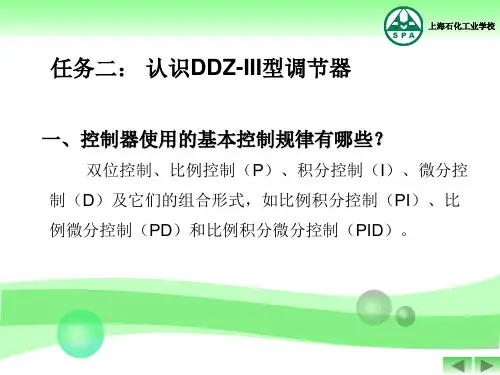
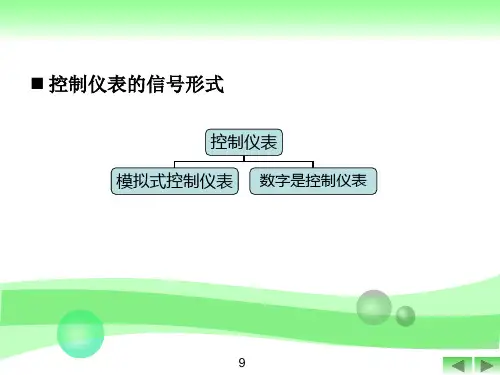
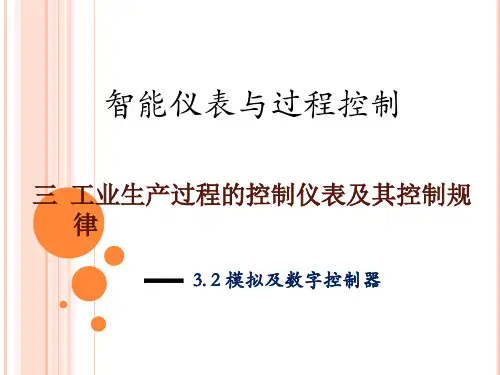
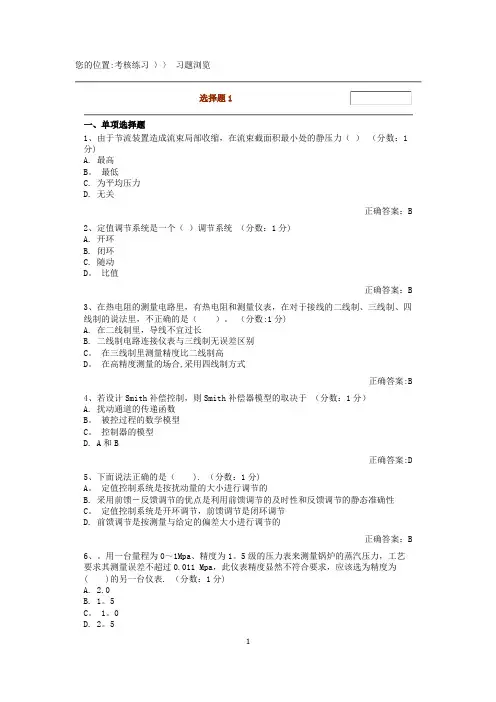
您的位置:考核练习〉〉习题浏览选择题1一、单项选择题1、由于节流装置造成流束局部收缩,在流束截面积最小处的静压力()(分数:1分)A. 最高B。
最低C. 为平均压力D. 无关正确答案:B2、定值调节系统是一个()调节系统(分数:1分)A. 开环B. 闭环C. 随动D。
比值正确答案:B3、在热电阻的测量电路里,有热电阻和测量仪表,在对于接线的二线制、三线制、四线制的说法里,不正确的是()。
(分数:1分)A. 在二线制里,导线不宜过长B. 二线制电路连接仪表与三线制无误差区别C。
在三线制里测量精度比二线制高D。
在高精度测量的场合,采用四线制方式正确答案:B4、若设计Smith补偿控制,则Smith补偿器模型的取决于(分数:1分)A. 扰动通道的传递函数B。
被控过程的数学模型C。
控制器的模型D. A和B正确答案:D5、下面说法正确的是(). (分数:1分)A。
定值控制系统是按扰动量的大小进行调节的B. 采用前馈-反馈调节的优点是利用前馈调节的及时性和反馈调节的静态准确性C。
定值控制系统是开环调节,前馈调节是闭环调节D. 前馈调节是按测量与给定的偏差大小进行调节的正确答案:B6、。
用一台量程为0~1Mpa、精度为1。
5级的压力表来测量锅炉的蒸汽压力,工艺要求其测量误差不超过0.011 Mpa,此仪表精度显然不符合要求,应该选为精度为( )的另一台仪表. (分数:1分)A. 2.0B. 1。
5C。
1。
0D. 2。
57、根据对象特性来选择控制规律时,对于控制通道滞后小,负荷变化不大,工艺参数不允许有余差的系统,应当选用()控制。
(分数:1分)A。
比例B. 比例积分C。
比例微分D. 微分正确答案:B8、常见的被控参数包括流量、()、压力、温度等。
(分数:1分)A. 液位B。
转速C。
偏差D. 锅炉正确答案:A9、在控制流程图里,T作为被检测量时,一般表示() (分数:1分)A. 液位B。
温度C。
压力D. 流量正确答案:B10、下列哪项不属于过程控制系统的常见被控对象(分数:1分)A。
![[第4讲]-自动化仪表及过程控制-第四章-过程控制仪表](https://uimg.taocdn.com/908249a56529647d272852bc.webp)
第四章过程控制仪表⏹本章提要1.过程控制仪表概述2.DDZ-Ⅲ型调节器3.执行器4.可编程控制器⏹授课内容第一节概述✧过程控制仪表---是实现工业生产过程自动化的重要工具,它被广泛地应用于石油、化工等各工业部门。
在自动控制系统中,过程检测仪表将被控变量转换成电信号或气压信号后,除了送至显示仪表进行指示和记录外,还需送到控制仪表进行自动控制,从而实现生产过程的自动化,使被控变量达到预期的要求。
过程控制仪表包括调节器(也叫控制器)、执行器、操作器,以及可编程调节器等各种新型控制仪表及装置。
过程控制仪表的分类:●按能源形式分类:液动控制仪表、气动控制仪表和电动控制仪表。
●按结构形式分类:基地式控制仪表、单元组合式控制仪表、组件组装式控制仪表、集散控制装置等。
[基地式控制仪表]以指示、记录仪表为主体,附加某些控制机构而组成。
基地式控制仪表特点:—般结构比较简单、价格便宜.它不仅能对某些工艺变量进行指示或记录,而已还具有控制功能,因此它比较适用于单变量的就地控制系统。
目前常使用的XCT系列动圈式控制仪表和TA系列简易式调节器即属此类仪表。
[单元组合式控制仪表]将整套仪表划分成能独立实现一定功能的若干单元,各单元之间采用统一信号进行联系。
使用时可根据控制系统的需要,对各单元进行选择和组合,从而构成多种多样的、复杂程度各异的自动检测和控制系统。
特点:使用灵活,通用性强,同时,使用、维护更作也很方便。
它适用于各种企业的自动控制。
广泛使用的单元组合式控制仪表有电动单元组合仪表(DDZ型)和气动单元组合仪表(QD2型)。
[组件组装式控制仪表]是一种功能分离、结构组件化的成套仪表(或装置)。
它以模拟器件为主,兼用模拟技术和数字技术。
整套仪表(或装置)在结构上由控制柜和操作台组成,控制柜内安装的是具有各种功能的组件板,采用高密度安装,结构紧凑。
这种控制仪表(或装置)特别适用于要求组成各种复杂控制和集中显示操作的大、中型企业的自动控制系统。
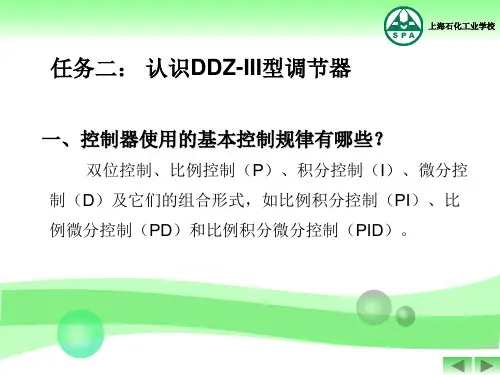
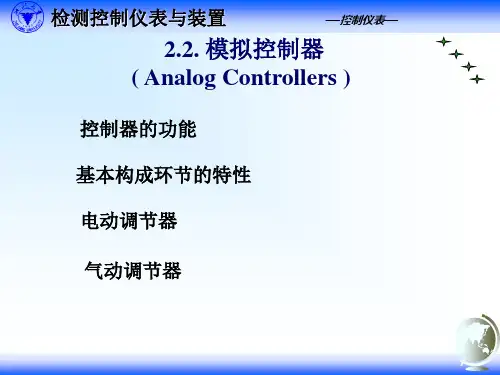
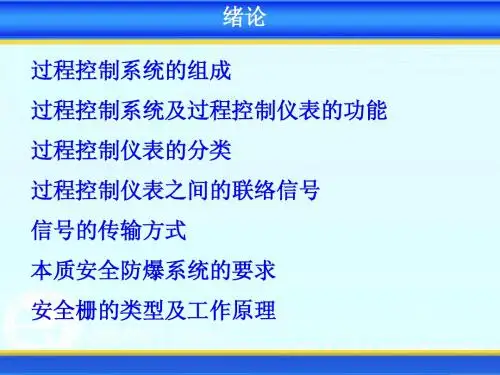
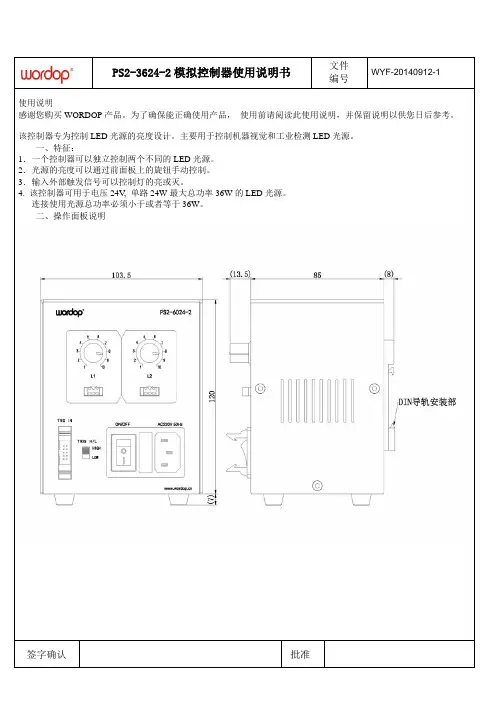
PS2-3624-2模拟控制器使用说明书文件WYF-20140912-1编号使用说明感谢您购买WORDOP产品。
为了确保能正确使用产品,使用前请阅读此使用说明,并保留说明以供您日后参考。
该控制器专为控制LED光源的亮度设计。
主要用于控制机器视觉和工业检测LED光源。
一、特征:1.一个控制器可以独立控制两个不同的LED光源。
2.光源的亮度可以通过前面板上的旋钮手动控制。
3.输入外部触发信号可以控制灯的亮或灭。
4. 该控制器可用于电压24V, 单路24W最大总功率36W的LED光源。
连接使用光源总功率必须小于或者等于36W。
二、操作面板说明签字确认批准三、规格参数型号PS2-3624-4发光方式常时发光/无级调光驱动方式恒压通道数2通道输入电压(额定)AC100V~240V触发功能有触发输入电压5~24V输出总功率(额定) 2通道合计36W输出电压(额定)DC24V输出电流(额定)单通道合计1.0A发光延时5us MAX使用环境温度0--40°C 湿度20--85%RH(无结霜状态)储存环境温度-20--60°C 湿度20--85%RH(无结霜状态)冷却方式自然空气冷却材质·表面处理SPCC 表面喷漆处理重量1KG标配配件触发线、AC电源线可选配件调光设定手动旋钮无级调光ON/OFF设定外部高低电平触发输入签字确认批准安装方法安装时:将连接器完全插入灯的连接插头移除时:解开锁扣然后拉出连接器从控制器底部取下橡胶脚垫,用螺丝刀将固定橡胶脚垫的螺丝取下来。
固定支架到底座,用支架带的四个螺丝将支架固定到底座上。
用安装螺丝固定控制器,用安装螺丝将控制器固定到正确的位置,安装螺丝由用户自备。
移除时:按住锁扣然后拉出连接器。
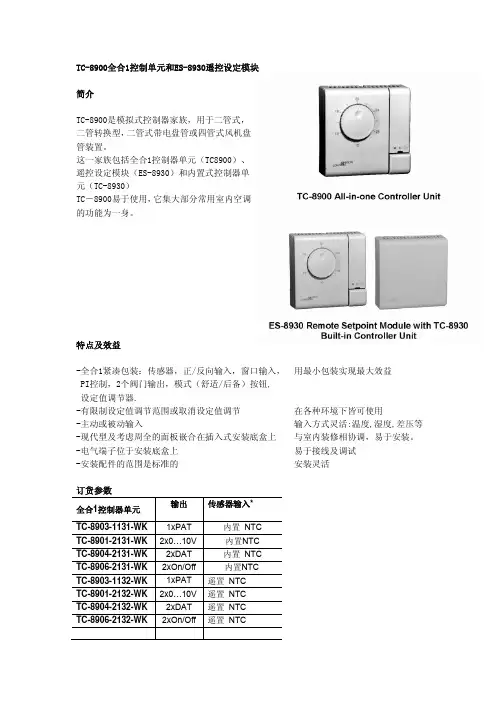
TC-8900全合1控制单元和ES-8930遥控设定模块简介TC-8900是模拟式控制器家族,用于二管式,二管转换型,二管式带电盘管或四管式风机盘管装置。
这一家族包括全合1控制器单元(TC8900)、遥控设定模块(ES-8930)和内置式控制器单元(TC-8930)TC-8900易于使用,它集大部分常用室内空调的功能为一身。
特点及效益-全合1紧凑包装:传感器,正/反向输入,窗口输入, 用最小包装实现最大效益PI控制,2个阀门输出,模式(舒适/后备)按钮,设定值调节器.-有限制设定值调节范围或取消设定值调节 在各种环境下皆可使用-主动或被动输入 输入方式灵活:温度,湿度,差压等 -现代型及考虑周全的面板嵌合在插入式安装底盒上 与室内装修相协调,易于安装。
-电气端子位于安装底盒上 易于接线及调试-安装配件的范围是标准的 安装灵活订货参数输出传感器输入*全合1控制器单元TC-8903-1131-WK 1xPAT 内置 NTCTC-8901-2131-WK 2x0…10V 内置NTCTC-8904-2131-WK 2xDAT 内置 NTCTC-8906-2131-WK 2xOn/Off 内置NTCTC-8903-1132-WK 1xPAT 遥置 NTCTC-8901-2132-WK 2x0…10V 遥置 NTCTC-8904-2132-WK 2xDAT 遥置 NTCTC-8906-2132-WK 2xOn/Off 遥置 NTC设定范围:12~28度输出传感器输入全合1控制器单元TC-8903-1151-WK 1xPAT 内置NTCTC-8903-1152-WK 1xPAT 遥置 NTC设定范围:0~40度输出传感器输入全合1控制器单元TC-8903-1183-WK 1xPAT 遥置0 (10V)TC-8901-2183-WK 2x0…10V 遥置0 (10V)设定范围:0~100%*遥置传感器输入:见本文件最后一页“技术规格”输出传感器输入内置控制器单元TC-8933-1112-W 1xPAT 从 ESTC-8931-2112-W 2x0…10V 从 ESTC-8934-2112-W 2xDAT 从 ESTC-8936-2112-W 2xOn/Off 从 ES*设定范围:遥控,见ES-8900遥控设定模块输出传感器输入*ES-8930-3031-WK --内置 NTC*设定范围:12~28摄氏度附件附件(分开定购)定购号 说明TM-9100-8900 传感器盒的开启工具TM-9100-8901 拨盘停止螺钉组(100只一包装的自攻螺钉)TM-9100-8931-W 塑料表面安装组件TM-9100-8941-W 墙装组件TM-9100-8951-W 面板安装组件附件详情见“RS-9100”产品手册技术特点-带NTC传感器输入的模块型号TC-8901 系列TC-8903 系列TC-8904 系列TC-8906 系列无控制作用带0 to 2 K - 0 to 2 K 0 to 2 K 差额- - - 0.2 to 2 K比例带1…4 K 2…8 K 1…4 K -分钟- 时间- 120 秒 5 (15)积分时间- 关闭或 4 分钟- - 备用偏差 BSB 2 K 2 K 2 K 2 K窗口偏差 BOF 5 K 5 K 5 K 5 K技术特点-带0-10V传感器输入的模块型号TC-8901-2183-WK TC-8903-1183-WK无控制作用带0 to 10% -比例带 5 to 20% 10 to 40%积分时间- 关闭或 4 分钟备用偏差 BSB 10% 10%窗口偏差 BOF 25% 25%应用TC-89x0控制器既可安装在墙上也可安装于风扇盘管之中,接收从遥置设定模块所发出的设定信息。
化工仪表及自动化教案第一章:化工仪表概述1.1 仪表的定义和分类1.2 仪表的作用和重要性1.3 仪表的性能指标1.4 仪表的选用和安装第二章:压力仪表2.1 压力仪表的分类和原理2.2 压力仪表的选用和安装2.3 压力仪表的校验和维护2.4 压力仪表在化工中的应用案例第三章:流量仪表3.1 流量仪表的分类和原理3.2 流量仪表的选用和安装3.3 流量仪表的校验和维护3.4 流量仪表在化工中的应用案例第四章:温度仪表4.1 温度仪表的分类和原理4.2 温度仪表的选用和安装4.3 温度仪表的校验和维护4.4 温度仪表在化工中的应用案例第五章:液位仪表5.1 液位仪表的分类和原理5.2 液位仪表的选用和安装5.3 液位仪表的校验和维护5.4 液位仪表在化工中的应用案例第六章:自动化控制系统基础6.1 自动化控制系统的概念6.2 自动化控制系统的基本组成部分6.3 控制器的分类和原理6.4 控制系统的性能指标和评价第七章:模拟式控制器7.1 模拟式控制器的原理和结构7.2 模拟式控制器的参数设置和调整7.3 模拟式控制器在化工中的应用案例7.4 模拟式控制器的故障诊断和维修第八章:数字式控制器8.1 数字式控制器的原理和结构8.2 数字式控制器的编程和操作8.3 数字式控制器在化工中的应用案例8.4 数字式控制器的故障诊断和维修第九章:执行器9.1 执行器的分类和原理9.2 执行器的选用和安装9.3 执行器在化工中的应用案例9.4 执行器的故障诊断和维修第十章:自动化仪表系统的安全性和可靠性10.1 自动化仪表系统的安全防护措施10.2 自动化仪表系统的可靠性设计10.3 故障检测与诊断技术10.4 系统维护和保养的注意事项第十一章:DCS(分布式控制系统)11.1 DCS的基本概念和组成11.2 DCS的架构和工作原理11.3 DCS在化工企业中的应用案例11.4 DCS的维护与管理第十二章:现场总线与工业以太网12.1 现场总线的概念与分类12.2 工业以太网的技术特点与应用12.3 现场总线与工业以太网在化工仪表中的应用12.4 现场总线与工业以太网的故障诊断与维护第十三章:过程控制仪表与系统13.1 过程控制仪表的分类与原理13.2 过程控制系统的组成与作用13.3 常见过程控制系统在化工中的应用案例13.4 过程控制仪表与系统的故障诊断与维修第十四章:化工过程优化与先进控制14.1 化工过程优化的基本方法14.2 先进控制策略及其在化工中的应用14.3 化工过程模拟与仿真14.4 化工过程优化与先进控制在实际生产中的应用案例第十五章:仪表与自动化在化工安全生产中的应用15.1 仪表与自动化在危险化学品生产中的应用15.2 仪表与自动化在化工环境保护中的应用15.3 仪表与自动化在化工安全生产中的重要作用15.4 安全生产中仪表与自动化的案例分析与总结重点和难点解析本文教案主要涵盖了化工仪表及自动化的基础知识、各类仪表的工作原理和应用、自动化控制系统的组成和性能、执行器的选用和安装、以及仪表系统的安全性和可靠性等内容。
类型不同的温度控制仪有什么区别简介温度控制仪主要用于控制温度,利用控制器的输出信号,调整加热、制冷等设备的状态,从而维持设备的稳定温度。
不同类型的温度控制仪在原理、使用场景、控制精度等方面不同,本文将着重探讨这些方面的差异。
原理数字式温度控制仪数字式温度控制仪以数字电路为核心,可以实现计算、存储、控制等多项功能。
其主要原理就是通过控制传感器的采集,将温度信号转换为数字信号,再通过控制输出的方式,控制温度。
模拟式温度控制仪模拟式温度控制仪基于模拟电路,使用模拟信号来控制温度。
模拟式温度控制仪对于输入信号和控制信号的电压要求较高,且使用寿命短,逐渐被数字式温度控制仪所取代。
使用场景数字式温度控制仪数字式温度控制仪广泛应用于各种工业、农业、生活等领域。
数字式温度控制仪的特点是易于调节,响应速度快,精度高,稳定性好。
适合在恶劣的环境下使用,并且能够实现多项智能功能。
模拟式温度控制仪模拟式温度控制仪使用寿命短,通常只适用于小范围的温度控制,例如实验室的小型设备。
对于精度要求较低,使用环境较为温和的场合下,选择模拟式温度控制仪也是一种不错的选择。
控制精度数字式温度控制仪数字式温度控制仪具有高精度、高稳定性的特点。
数字式温度控制仪通过数字处理电路的精细控制,能够在更大的范围内实现对温度的控制和调节。
数字温度控制仪的精度通常在±0.2℃,甚至更高。
另外,数字式温度控制仪还具有抗干扰能力强,不易受周围环境的影响等优点。
模拟式温度控制仪模拟式温度控制仪控制精度一般较低,通常精度可达±1-2℃。
模拟式温度控制仪的调节灵敏度较低,不如数字式温度控制仪容易受到外界环境影响。
但是,由于其使用的电路较为简单,通常价格相对数字式温度控制仪较为便宜。
结论不同类型的温度控制仪在原理、使用场景、控制精度等方面各有不同。
由于数字式温度控制仪具有高精度、高稳定性等优点,目前已经成为主流的温度控制仪。
而模拟式温度控制仪则逐渐退出市场。
自动控制仪表简述一.自动控制仪表的作用自动控制是指再没有人直接参与的情况下,利用控制装置(控制器),使机器、设备或生产过程(被控对象)的某一工作状态或参数(被控量)自动按照预定的规律运行。
自动控制是可以在检测的基础上,在应用控制仪表(常称为控制器)和执行器来代替人工操作。
自动控制仪表在自动控制系统中的作用是将被控变量的测量值与给定值相比较,产生一定的偏差,控制仪表根据该偏差进行一定的数学运算,并将运算结果以一定的信号形式送往执行器,以实现对于被控变量的自动控制。
二.自动控制仪表的分类及其特点1.按控制仪表的结构形式分类(1)基地式控制仪表⑴原理:基地式控制仪表是将测量、变送、显示及控制等功能集于一身的一种控制仪表。
它的结构比较简单,常用于简单控制系统。
⑵目前流行的仪表:有MOOR公司的XCT340 D-B、SMAR公司的LD301和KF系列。
⑶存在的问题:①气动基地式仪表(例如KF系列)要比电动基地式仪表的价格贵l倍还要多;②目前电动基地式仪表还未国产化,尚需进口;③气动基地式仪表对气源质量要求高。
往往由于气源净化不好而不能投入自动。
⑷发展方向:电动基地式仪表的发展趋势是全部采用现场总线技术,将一些本属于控制室中控制器的功能下放到现场型仪表中,从而更加拓宽了其使用范围。
不但简化了系统,节约了投资。
而且利用现场总线的双向通信功能,可由现场向控制室发出测量参数、维修预报以及故障诊断等信号,同时,也可在控制室对电动基地式仪表进行在线组态、设定、维护及调整。
(2)单元组合式仪表⑴原理:单元组合式仪表把整套仪表按照其功能和使用要求,分成若干独立作用的单元,个单元之间用统一的标准信号联系,使用时,针对不同的要求,将个单元以不同的形式组合,可以组成各种各样的自动检测和控制系统。
图1-1用电动单元组合仪表构成的调节系统⑵单元组合式仪表的分类(按使用的能源来分)①气动单元组合式仪表:以电作为能源及传送信号的仪表.这种仪表具有响应快速,易于控制和远距离传送,便于与各种电子装置、计算机等配合,可构成各种复杂的综合控制系统,发展十分迅速,在生产中被广泛应用。